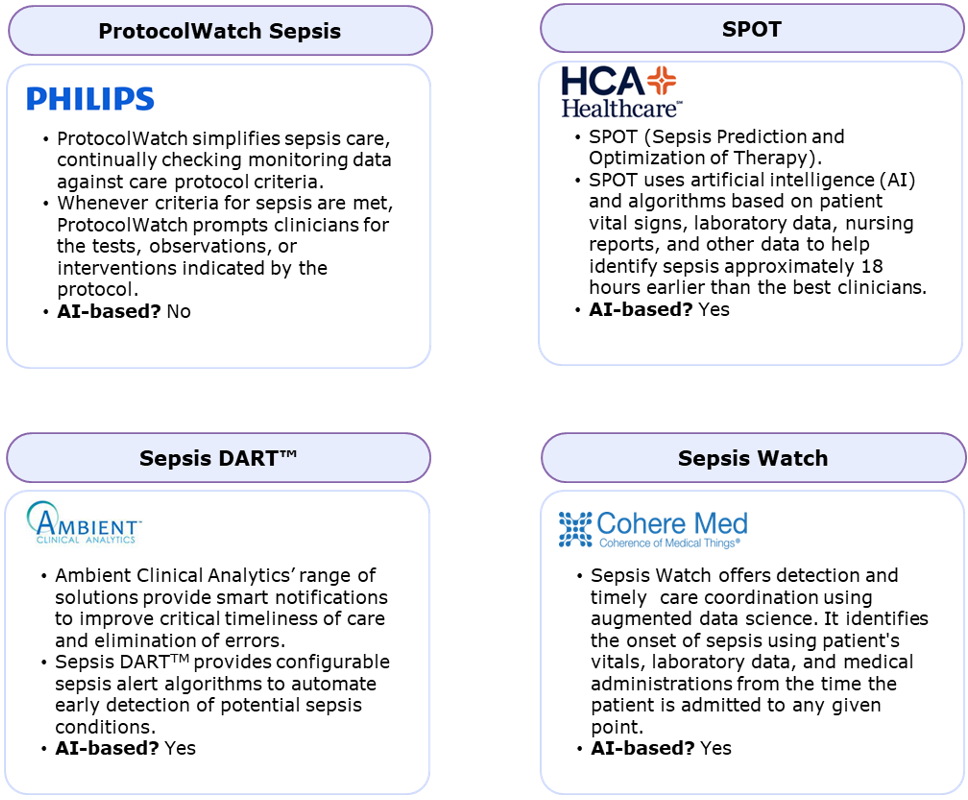
Written by

8th September 2022
US-based Bayesian Health recently announced the publication of clinical evidence to support its AI-driven early-warning clinical decision support platform for Sepsis detection. Its Targeted Real-Time Early Warning System (TREWS) was shown to reduce mortality from sepsis by 18% with the timely use of the platform. Although not the first solution to use AI in sepsis detection, it is the first time clinical evidence has been provided to prove a reduction in mortality.
About Bayesian
- Bayesian Health was founded by Dr. Suchi Saria in New York, USA and has developed an AI-based/machine-learning platform (Targeted Real-Time Early Warning System (TREWS)).
- TREWS integrates into a hospital’s EHR and securely incorporates and analyses disparate patient data utilising AI and machine learning models.
- The model also learns from additional input received from the clinician should they disagree with the information provided.
- TREWS provides accurate and actionable clinical signals, enabling healthcare staff to catch life-threatening complications and identify patients at-risk of adverse events early, facilitating timely diagnosis and intervention.
- TREWS has yet to receive FDA 510k status. However, the company’s above-mentioned large outcome study showed 89% physician and care team adoption, led to sepsis treatments occurring 1.85 hours earlier than when not used.
Why the noise?
Sepsis accounts for one in five deaths globally and is the most common cause of deaths in the hospital in the US. A study published in the Lancet in 2020 identified that there was 48.9 million cases of sepsis in 2017 globally, resulting in 11 million deaths. The elderly and children under 5 years accounted for the highest incidence of deaths, further highlighting the need for early detection to reduce mortality risk. The COVID-19 pandemic is thought to have also increased the mortality incidence from Sepsis further, due to infection post-virus.
Even prior to the pandemic, healthcare staff shortages were frequently publicised, with hospital staff often pushed to their limits. Early-warning scoring in many countries is still very much a manual process, using measurements of vital signs and subsequent colour-coding of patient status on a white board in the nurse’s station. With limited staff, it can be easy to miss changes in patient deterioration if vital signs are not monitored frequently. With mounting pressure on stretched hospital staff, interest in solutions that automatically flag patient deterioration using vital signs information has increased. Value-based care has also further driven the focus to improve the level of care provided; hospitals are more liable for their care provision with funding at risk if patient care is below the standards expected. This is creating a new demand for solutions that can help advance patient care.
Digitalisation of healthcare
The digitalisation of healthcare systems has resulted in a plethora of patient data being integrated into information systems and subsequent electronic medical records. The significance of data can often be lost if left unorganised and not utilised to its fullest capacity. Clinical decision support solutions can collate data and identify missing pieces of information to provide a complete picture of the patient’s status and to support the treatment pathway. The ICU specifically has been a focus of many AI solution providers, with real-time analysis and support of data to provide actionable clinical decision support in time-critical situations. Several products have gained FDA approval in recent years to help improve data analytics with some taking the next step to utilize artificial intelligence. Significant progress has been made to provide real-time alerting to patient deterioration to improve patient care. The recent learnings from the pandemic are expected to fuel the demand for similar solutions moving forward, especially in the ICU department. However, regulatory processes are often both time-consuming and costly, requiring significant data to prove clinical benefit.
Other Innovation leaders
As part of its High Acuity & Perinatal IT report, Signify Research assessed several AI-based applications and dashboards utilised in the high-acuity setting. Signify identified other vendors also focusing on sepsis detection, including:

The future of AI in early-warning scoring
In recent years, the drive to lower costs has resulted in a change in clinical care practice, with a gradual shift of patients to lower-acuity settings much earlier in their patient pathway. With a lower nurse-to-patient ratio in these settings, technological advancements are necessary to highlight changes in patient status. Continuous monitoring is expanding to low-acuity settings, such as step-down wards, general wards, ambulatory centres, and the home. There continues to be a flurry of AI-based solutions that promise to assist in the early-detection of patient deterioration and specifically in sepsis. Bayesian Health’s solution has demonstrated the positive outcomes that AI-based applications can have on detecting sepsis and reducing risk of mortality. The clinical evidence to support the positive outcomes from utilising the platform is expected to create momentum within the industry, with other vendors striving to support their own solutions with proven clinical outcomes. The next step for Bayesian will be to gain regulatory approval for wider utilisation.
In the short-term, solutions like that from Bayesian Health will continue to be developed and will be offered as add-on applications to enhance existing clinical information systems. Uptake will be further driven by the publication of supporting evidence and clinical benefits seen from utilising these solutions. Bayesian Health has created a good platform for other vendors to springboard from, to show the true benefit of solutions that can protect the patient. It is expected that many of these solutions will eventually be integrated into automated warning systems to offer enhanced confidence in patient monitoring practices. However, global uptake will vary depending on the regional protocols, and how well accepted early-warning scoring really is.
About the Report
High Acuity and Perinatal IT Report – World – 2021 provides a data-centric and global outlook of the high acuity and perinatal clinical information systems markets. The report blends primary data collected from in-depth interviews with healthcare professionals and technology vendors, to provide a balanced and objective view of the market.
About Signify Research
Signify Research is an independent supplier of market intelligence and consultancy to the global healthcare technology industry. Our major coverage areas are Healthcare IT, Medical Imaging and Digital Health. Our clients include technology vendors, healthcare providers and payers, management consultants and investors. Signify Research is headquartered in Cranfield, UK. To find out more: enquiries@signifyresearch.net, T: +44 (0) 1234 436 150, www.signifyresearch.net
More Information
To find out more:
E: enquiries@signifyresearch.net,
T: +44 (0) 1234 436 150
www.signifyresearch.net